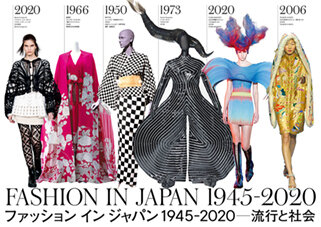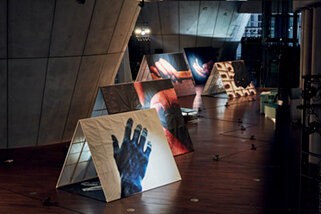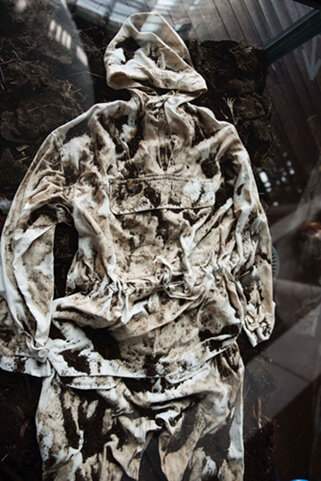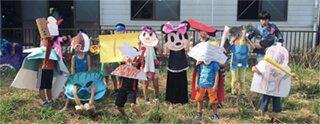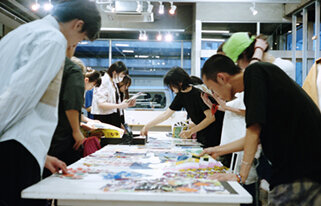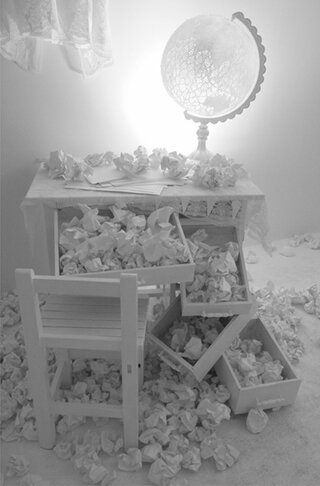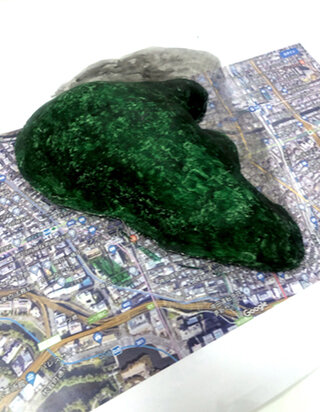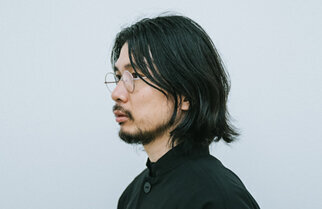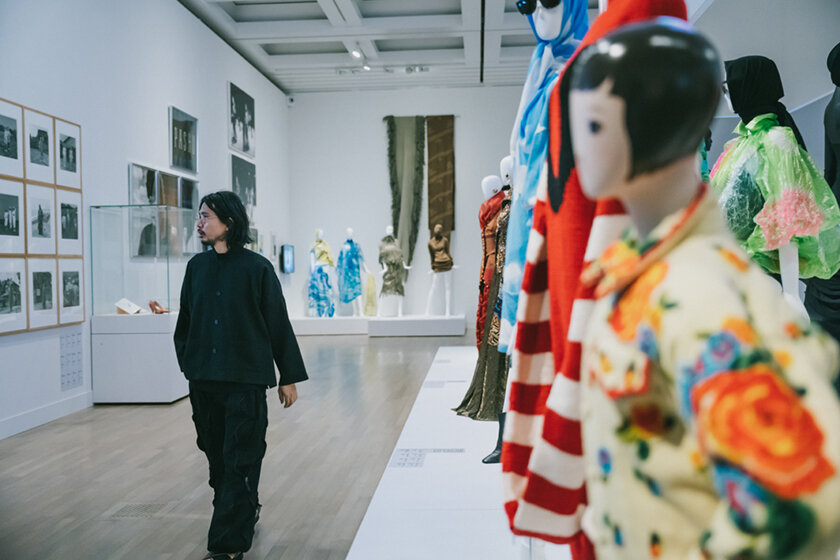
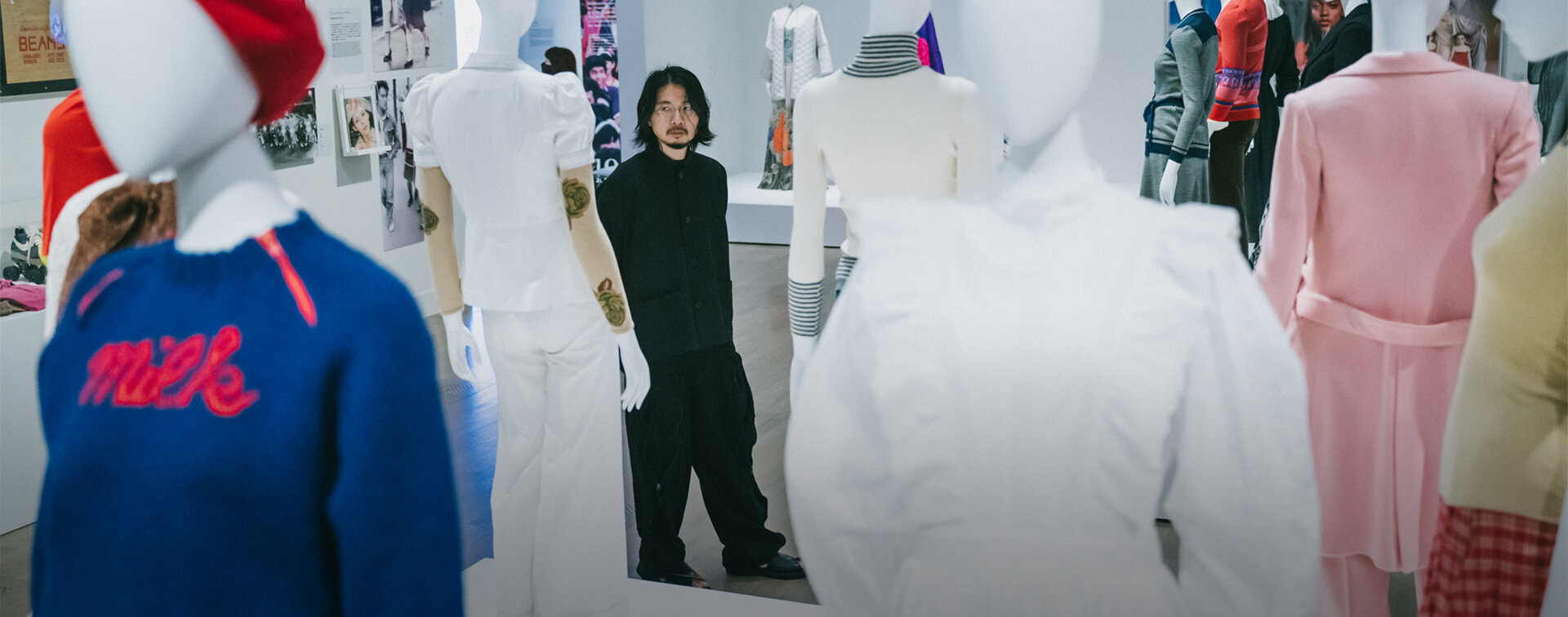
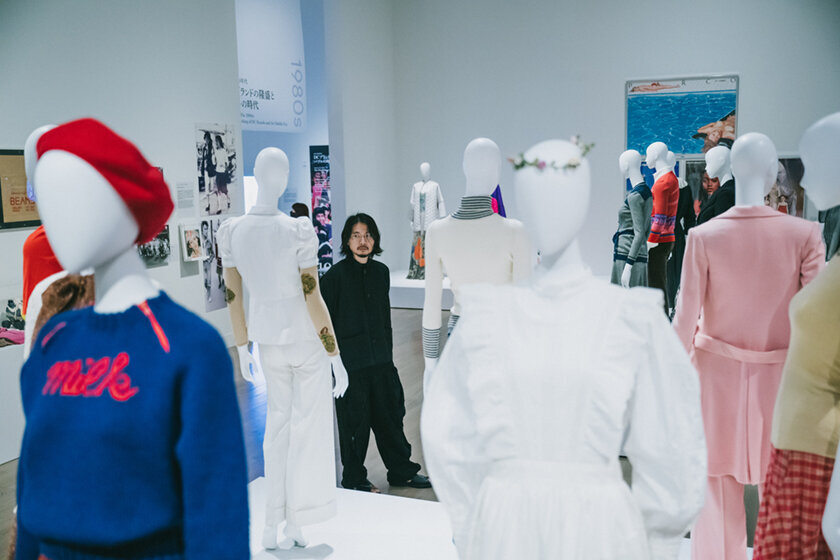
INTERVIEW
128
Yoshikazu YamagataFashion Designer / Educator
Urban Development that Shows Respect for Craftspeople and History
Lending contiguity to world class techniques and creations
After serving as a design assistant to John Galliano while attending the prestigious Central Saint Martins in London, Yoshikazu Yamagata graduated at the top of his class and returned to Japan to establish his own fashion brand “writtenafterwards” at a relatively young age. In 2008, he went on to found “coconogacco” in pursuit of providing a more open and flexible place for fashion education. Yamagata envisions fashion as a means of living with a future where dressing up and nature are on the same trajectory as a matter of course. He continues to work at a level that transcends society’s concept of fashion, producing creations that have a thermal energy about them. What does he hope to bring to people, society, and cities? To get a glimpse into his mind, we interviewed him with a focus on the Fashion in Japan 1945-2020 exhibition currently on at The National Art Center, Tokyo (until September 6, 2021) to ask about his current thoughts and things that can be done for the future.
We need fashion cycles that don't separate humans from nature
From the 1990s to the 2010s, trend cycles accelerated at incredible speeds in the world of fashion. Increased globalization regularized mass production and consumption, spurring on the trend of fast-tracking market delivery. I think that's been taking its toll on both the design and the production side in recent years.
But then with the COVID-19 pandemic, the established cycles didn't work anymore and it was an opportunity to rethink the existing flow of things, in a way. Instead of artificially imposed fashion cycles, we need to rethink dress in terms of cycles that include nature as well as humans. I think that's the kind of thing that people are feeling on a global scale.
I was invited to be a part of the current Fashion in Japan 1945-2020 exhibition before the pandemic. I originally had the vague notion of wanting to show some kind of new idea, but when the general mood shifted with the pandemic experience, my desire to present something in 2021 that serves as "the next step" grew stronger.
FASHION IN JAPAN 1945-2020 ―流行と社会
The exhibition provides a comprehensive overview of Japanese fashion, with a look at fashion culture created from Japanese minds and the rich expression born from societal circumstances and trends from the Meiji Era onwards. With social and historical context, it unravels modern Japanese fashion that was the object of global fascination from the era of kokumin-fuku (de facto civilian uniforms) and monpe work pants during and after World War II, to creations produced from the prominent rise of Japanese designers on the global stage, kawaii culture originating from young Japanese people, and finally to a sustainable near future. The exhibition will run until Monday, September 6, 2021 at The National Art Center, Tokyo (Special Exhibition Gallery 1E).
A positive cycle that connects dressing up with a return to nature
That was around when I had the opportunity to work with Ganryu-san of the fashion brand FUMITO GANRYU at a March event that was held to kick off the exhibition. It was called the FUMITO GANRYU + Yoshikazu Yamagata (writtenafterwards) show, where I created an installation piece in a section of The National Art Center, Tokyo, and the FUMITO GANRYU AW21 RUNWAY SHOW was held in the same space. That was where I displayed clothes made out of washi paper in a glass case together with soil, which links to my project Gassho (lit. hands together in prayer) in Fashion in Japan 1945-2020, where I display the process of clothes decomposing into soil in thinking about new roles for clothing and fashion.
FUMITOGANRYU+Yoshikazu Yamagata(writtenafterwards)ショー
As a part of Rakuten Fashion Week TOKYO, FUMITO GANRYU and writtenafterwards held a joint fashion show that was the first such event held at The National Art Center, Tokyo. An installation by Yamagata spiced up the space where FUMITO GANRYU held a runway show for its 2021 Autumn Winter collection. The show was streamed online, including footage from cameras held by the runway models themselves, making for a creatively innovative event.
Gassho
An installation that puts soil and clothing together in a glass case to present the natural cycle of fibers being broken down by microorganisms and eventually decomposing back to soil. According to Yamagata, "Because of the museum setting, I couldn't actively incorporate UV rays into the installation and I had to try and keep bacterial growth at a minimum. This meant I couldn't use UV rays to stimulate the microorganisms to show the process of biodegradation. I don't know what kind of ecosystem will develop in a glass case that's inherently bacteria-free, but I hope that there'll be some kind of visible transformation during the course of the exhibition."
Fabric made from washi paper has always been used in Japanese clothing, but recently its use has undergone quite an update. Advancements in research have shown that washi paper biodegrades very quickly with excellent composting properties that enrich soil. As the environmental burden of fashion has been met with increasing scrutiny in recent years, I work in hopes of devising something that can link "dressing up" with "returning to nature," in a positive way at that. This challenge involves such a complicated dilemma that I don't have a clear direction to work towards yet, nor do I even know if there's an answer at all, but I hope to keep feeling my way forward.
Beyond just my project, I think this exhibition is a big important step in Japanese fashion history. Come to think of it, there have been very few exhibitions of the like that provide an overview of postwar Japanese fashion history. There have been exhibitions that featured the lives of individual designers or era-specific trends, but this exhibition also includes clothes that were not created by fashion designers and takes a look at the history through resources other than clothing such as photos and video footage. It reminds me that Japan is a place where clothing came about from all kinds of different angles. I think being able to get a comprehensive view of how fashion in Japan changed over the years is what makes this exhibition so important.

Fashion that provides care for people who live in an increasingly complex society
Having gone through the kind of history presented in the exhibition, how is contemporary fashion changing right now? With social media visualizing people's need for recognition, I feel that there has been a huge acceleration in something arguably fashion-like, and that it has given rise to new ways of enjoyment. In that sense, society's newfound interest in this broader definition of fashion has an incredible amount of energy. But if we're just talking about clothing, I think there might be less enthusiasm for that, relatively speaking. But perhaps that simply means that fashion has become a form of expression that isn't exclusive to clothing, and not necessarily that the amount of attention has waned.
But even if the amount of attention does change, I think fashion will always be the form of media that is most intimately connected to self-expression and the need for recognition. Today, there are many venues for self-expression through personal media that replicate "the self," resulting in multiple versions of each individual. This is complicating social structures, and I think it's important to think about ways of creating and developing systems that let fashion adapt to each environment.
For example, providing physical and emotional care for yourself when your identity has become increasingly complex is something we should focus more on. Fashion functions to help deal with the outside world--a kind of mediator between yourself and others. In that sense, I think fashion could provide hints for potential solutions when faced with problems such as emotional or interpersonal issues.
I once did a workshop with autistic children. I called it a "transformation workshop" where we made masks to become a different version of ourselves. When the children put their masks on, it brought out personalities, expressions, words, and actions that were completely different from the children's usual selves. In that way, I think clothing has the potential to switch yourself over to becoming something different. I think it could offer possibilities in a wide variety of fields, including medical treatment.
Transformation workshop
A workshop that was held in Itoshima City, Fukuoka Prefecture. Participating children designed what they wanted to transform into on a piece of drawing paper, from which they created masks and other things they could wear with help from adults.
Fashion is a medium and a communication tool that has always been with us since humankind first appeared on Earth. In a sense it offers a peek into the origins of humanity, so while its superficial elements are important as well, I'm sure it has more fundamental roles to fill that will be very important for the future.
Clothing worn that becomes food. Thinking from a different angle could have an impact on the future?
For example, I think it's essential to rethink the current social structure where short-term mass production and consumption is the norm. It's an extreme trend that has really accelerated in the last few decades, so we need to actively combat the situation in some way. Specifically, I think it's important to reintroduce the idea of "wearing fewer things longer," which was a normal concept not too long ago. I realize these words have been said so many times that they're almost embarrassingly clichéd, but you know the idea that it's a good thing to take care of things so that they last a long time? Well, if less people scoffed at that idea for being "phony and insincere," if that was the underlying sentiment in society, I think society's values would have the chance to change over time. Guiding things in that direction is one of the responsibilities I feel we have as people involved in the fashion industry.
Another thing that needs to happen is to convert existing energies in the right way. There's a story I heard once that I think is really interesting. I forgot the name...but there was someone who ran an experiment that took advantage of how computer users in pursuit of adult content repeatedly click through a multitude of buttons. The experiment converted the energy from the repeated button clicks driven by desire, and used that to unlock a difficult password, or something like that. It's pretty amazing that the computer users' desires and need for recognition--things that we think are the opposite of being useful--can unwittingly help with something. That's really thinking about things from a different angle.
In applying that to clothing I thought a similar way of thinking from a different angle would be if clothing worn out of a desire for social recognition eventually decomposed to became compost for growing pretty flowers and tasty vegetables. Dressing up to go out would inadvertently make animals and plants happy, and your clothes would ultimately become part of your flesh and bone in the form of cells. From olden times, medicine was called "naifukuyaku," and taking it was called "fukuyaku," where "fuku" is the kanji character for "clothes." There is some indication that people in the past used to think of the things worn on the outside of the body and the things that they took into their bodies as linked somehow. Based on that concept, my hope is to develop somewhat more positive circulation systems that show people how clothes worn on the outside of the body can be converted into food that eventually becomes a part of your own skin.
This kind of energy conversion and thinking about things from a different angle is what I want to do from here on out using clothes. In addition to expressing the tender joy that comes from dressing up, I think it's important to simultaneously explore possibilities for fashion to function as a way to care for or cure emotional or physical issues, as I mentioned before.
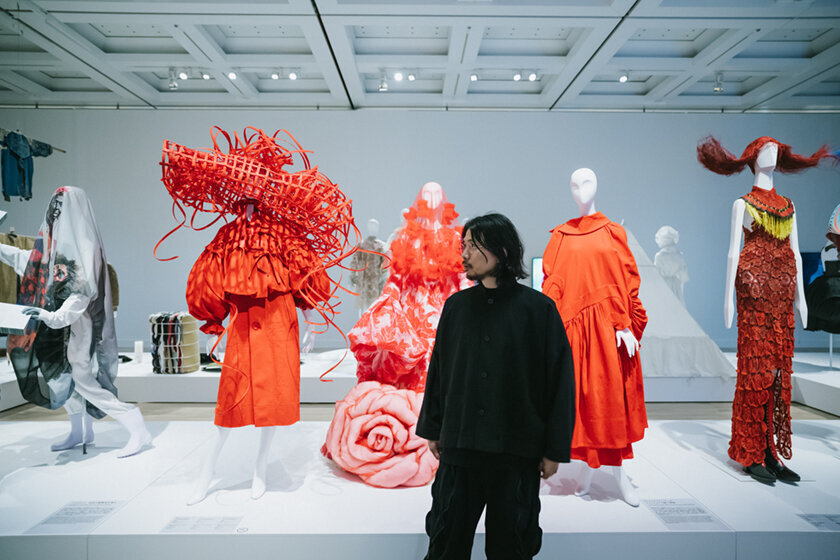
Exploring yourself in a user-led clinical research way exposes problems in society
I feel that fashion has great potential in treating emotional issues. This is because the process of creative expression in fashion involves digging deep down to see who you really are in a user-led clinical research kind of way and how the resulting expression includes an awareness of social issues. That is something I prioritize in the "coconogacco" educational space that I run. Of course, the students there learn how to create fashion, but they all start by considering the question "What is fashion, exactly?" After all, you can't separate the environment and yourself in fashion creation. The environment creates who you are, and recognizing that it has an impact, both consciously and unconsciously, on how you dress--in other words, examining your roots--leads to one's creative expression.
coconogacco
A school for fashion education that Yamagata opened in 2008, where students examine the roots of clothing around the world as well as how they themselves dress. "Coco" can mean both "here" and "each individual," and the name of the school means "a school that is where the students are now" as well as "a school for each student as an individual." The school values teaching the students not just knowledge and skills but also how to examine their artistic roots.
Learning about your own history, your own roots, as well the environment that made you who you are... The school puts weight on having students share these factors to help think about them together with others. To give those factors concrete form, I have each student create what we call a "research book." The students are free to use the books as they like: they can collect things to paste inside like a scrapbook, draw in them, or write in them, whether it's about things that interest them or something that represents their roots.
Making research books was a standard practice at the school I attended in London. It was more about developing projects than doing research on yourself, but it did help me learn about myself. Facing the psychological complexes you have is also an important part of learning about yourself. Sometimes when you examine whatever complex you have, it leads to a bigger social issue that caused the complex to develop in the first place. I never used to be good at communicating and I didn't do very well in school. I lacked confidence and led a life where I was basically ridiculed all the time. But now some of that past has become the energy that drives me today. I hope that the research books will help guide the students in some way through the course of their lives.
Examining local history to think about creating things and cities
The location of where coconogacco is based is also an important factor. I always thought that one important key to creating things in Tokyo was to be located on the east side. The east side of Tokyo was originally where craftspeople lived and worked with a long history of craftsmanship, which is why the school is currently in Asakusabashi. This isn't inclusive to Japan, but many Asian countries had their individual cultures turned on their heads with the new values that came with Westernization after World War II. Thinking about creating things in a culture with that kind of convoluted history requires a kind of environment that allows us to think about how our original values and history led to where we are today.
I usually spend most of my time in the Ueno and Yanaka areas, which were not bombed as heavily during the war. A lot of the old buildings there are still intact. I can regularly interact with craftspeople and historical buildings in those towns, which also have a certain traditional appeal. Coming from a rural area, I also have a habit of looking for places that remind me of the countryside. When I returned to Yanaka after going on a business trip to Yamanashi Prefecture one time, I remember the sense of comfort that welled up inside of me at the contiguity in atmosphere I felt coming back from the countryside in Yamanashi to the town of Yanaka. I realize this depends on the individual, but in my case the east side of Tokyo is good for me in terms of my emotional wellbeing as well.

Layering memories of a location on current townscapes
Because I spend most of my time on the east side, I rarely have the opportunity nowadays to go to the area around Roppongi where the exhibition is now being held at the The National Art Center, Tokyo, unless I'm setting up a show. But that doesn't mean that I don't feel a connection. My first chance to present after establishing "writtenafterwards" was an exhibition held at 21_21 DESIGN SIGHT called New Creators Met Together in Europe. The location holds a lot of meaning for me as the place where I presented my creations to the public for the first time ever, and I hope it continues to function as a venue where people can always see what new creations are out there, regardless of whether they are by newcomers or established designers.
New Creators Met Together in Europe
An exhibition at 21_21 DESIGN SIGHT in 2007 as part of Japan Fashion Week in TOKYO. It attracted attention for featuring creations by up-and-coming fashion designers who all went to prestigious schools in Europe and met each other at fashion contests and events in various countries. Yamagata participated as one of the six brands featured, as did Demna Gvasalia, who is currently the creative director at Balenciaga.
When thinking of creating with the town as a stage, a fundamental part of the way I work is to unravel the history of a location and connect that to the present day. For example, I'm currently working on a project called Small Mountain in Tokyo for the Tokyo Biennale 2020/2021. I was inspired by the fact that there used to be a mountain called Mt. Kanda where Kanda Myoujin Shrine now stands. Long ago, Mt. Kanda was leveled so that material from it could be used to fill the inlet that is now the Hibiya area. My project thinks about what it would be like to recreate Mt. Kanda.
Small Mountain in Tokyo
At the show After Wars held during the Decoration never dies, anyway exhibition at the Tokyo Metropolitan Teien Art Museum (2017), Yamagata presented some costumes with the concept of "wearing mountains." This project is an extension of that concept where a virtual image of Mt. Kanda in the spot it used to be is recreated in Tokyo, which otherwise has no view of mountains. It will be available at Tokyo Biennale 2020/2021, which is scheduled to run from July 10 to September 5, 2021 in the northeast part of the center of Tokyo (the area spanning four wards: Chiyoda, Chuo, Bunkyo, and Taito).
I grew up in an area surrounded by mountains, so a part of me wishes there were mountains in Tokyo. Actually, making a mountain materialize would require a tremendous amount of funds and labor, so I decided to create a virtual mountain for starters. Holding a smartphone up to that location reveals the model mountain I designed, and I hope that viewers will spend a brief time savoring what the area might have looked like back in the day. Roppongi is also full of ups and downs geographically, and there must be so much history to unravel there. I'm sure that a closer investigation would reveal more possibilities for inspiration. Personally, I'm very interested in the type of area development that connects to past histories. Roppongi was also a military town where both the Imperial Japanese Military and the U.S. military were based at separate times, so I would like to hold an exhibition there someday that examines the relationships between war, peace, and fashion.
The potential of regional areas, and what Tokyo should do on the other hand
In relation to area development, I have had quite a few opportunities to go to places that are a little ways away from Tokyo. Partly via collaborative exhibitions and creative projects we do at "coconogacco", I have a relationship with Fujiyoshida City in Yamanashi Prefecture, which I think has enormous potential. It's located a little less than two hours from Tokyo, but it has a great atmosphere characteristic of historic towns with some very lovely buildings still standing. They make lavish use of some of these locations as well, such as a store in a building that has been around for more than a hundred years. They have managed to use the proliferation of the internet to reduce their rural disadvantage in terms of business, which I think is pretty amazing.
Decomposition of Creation
An exhibition in Fujiyoshida City, Yamanashi Prefecture, held in collaboration between textile craftspeople and students at "coconogacco" during the 2020 school year. Fujiyoshida City has been famous for its textiles since the Heian Period (794-1185), and attracts highly skilled craftspeople as well as fashion brands.
Fujiyoshida has a lot of craftspeople who work in tiny family-owned businesses, helping each other out in the community. They are active in working to invigorate the town, with flexible attitudes toward outsiders like myself and students who come from elsewhere. It's a wonderful place, and spending time there has really made me think about the potential specific to regional areas. It also makes me think about what Tokyo should do be doing on the other hand.
A respect for craftspeople and collaboration should light the way for the future of creating things
Even from a global perspective, Japan has a lot of amazing craftspeople. It's such an amazing environment for crafts that they say of the developed countries in the world, Japan or Italy is the best place to find artisans. For example, although a surprising number of Japanese people don't know this, much of the fabrics for luxury brands such as Chanel are made in Japan. Globally top-class techniques and materials are available right here and the industry is relatively accessible in a good way, which means all kinds of people can get involved. This kind of environment is pretty hard to find anywhere in the world, and I think Japan has a lot of potential in terms of creating things.
One challenge in making the most out of this environment is overcoming the ill effects of the industry's existing pursuit of efficiency. The different processes have been broken up into so many separate fields for the sake of efficiency that it is now difficult to create mutual understanding and communication. For example, HERMÈS in France has the craftspeople at its core, with the design team situated alongside them. Apparently, the craftspeople always get to eat meals first. That's how much the company puts craftspeople first and foremost. In contrast, I feel that in Japan there is a lack of respect for craftspeople, who are sometimes even excluded from the product development phase, so I hope that will change over time. There is already so much potential in terms of technique and environment, so now it's important to value the craftspeople and collaborate with them to create things in ways that accommodate them properly. I think that's what will lead us to a better future.
Photo location: Fashion in Japan 1945-2020 at The National Art Center, Tokyo (currently running until September 6, 2021)
Editor's thoughts
Through the interview, I felt that Yamagata-san sees things from a non-fashion designer perspective, in a good way. I'm sure it's partly due to his experience as an educator, but his scope is so expansive that it seems wrong to label him as a "designer." His attitude has so much freedom, depth, and flexibility, on a level that many educators very rarely attain. I think his way of thinking might encompass the entire planet, or even the entire universe. That's how much depth of scope I sensed in him. (text_akiko miyaura)
RANKING
ALL
CATEGORY




